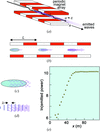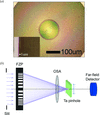issue contents
March 2011 issue

Cover illustration: Pb L3 fluorescence intensities of a line scan across the tidemark of a bone sample correlated with the reflected light micrograph of the sample surface (see Meirer, Pemmer, Pepponi, Zoeger, Wobrauschek, Sprio, Tampieri, Goettlicher, Steininger, Mangold, Roschger, Berzlanovich, Hofstaetter and Streli, pages 238-244). The positions TM1 indicate the positions where XANES scans were performed [spot size, 150 µm (horizontal) × 100 µm (vertical)].
facility information
research papers
Open  access
access
 access
accessAn elementary derivation of fundamental properties of X-ray free-electron lasers is presented, including gain and saturation. Because of its simplicity, this approach is particularly suitable for teaching at different levels and for presentations to non-specialized audiences.
Vibration sources are identified at four beamlines/endstations at the Canadian Light Source.
Open  access
access
 access
accessThe automatization tools for high-throughput tomographic microscopy developed at the TOMCAT beamline of the Swiss Light Source are described
Open  access
access
 access
accessA tunable X-ray focusing and/or monochromating device, called a transfocator, is described. Examples of its implementation on ID11 at the ESRF are given.
Open  access
access
 access
accessOperation of an X-ray spectrometer based on a spherical variable-line-spacing grating is analyzed using dedicated ray-tracing software allowing fast optimization of the grating parameters and spectrometer geometry.
The focused X-ray microbeam with Si-based Fresnel zone plate was successfully utilized to fabricate patterns with features as small as 100 nm on a photoresist.
A fast-readout pixel array detector is evaluated for small-angle X-ray scattering experiments.
An analog integrating pixel array detector sufficiently fast to isolate synchrotron bunches is presented and tested. The device is appropriate for time-resolved single-crystal Bragg reflection experiments or high-speed beam characterization.
A detailed overview of a new QEXAFS data acquisition system is given and its performance is characterized. All important features are explained with examples, and crucial design parameters of a QEXAFS set-up are discussed.
Open  access
access
 access
accessThe new implementation of QEXAFS acquisition on the general purpose EXAFS beamline BM29 at the European Synchrotron Radiation Facility is presented.
Open  access
access
 access
accessA new method of performing Mössbauer spectroscopy using a fast shutter in combination with microfocused synchrotron radiation is demonstrated.
Open  access
access
 access
accessPhosphorus K-edge XANES spectra are presented for a diverse set of 44 phosphate minerals.
It is found that X-ray focusing using flexible saw-tooth refractive lenses suffers significantly from aberrations. A solution for removal of the aberrations is presented, which will permit diffraction-limited operation of such lenses.
A set-up is presented to measure element-resolved magnetization dynamics with a temporal resolution well below 100 ps in the time domain. X-ray resonant magnetic scattering with a diffractometer set-up enables the investigation of magnetic thin films, multilayers and laterally structured samples.
Open  access
access
 access
accessLens- and fiber-coupled X-ray detectors with identical CCD chips were compared in their performance in high-resolution computed tomography experiments.
Open  access
access
 access
accessA multi-frame acquisition scheme for efficient energy-dispersive X-ray magnetic circular dichroism at the Fe K-edge is presented.
The `M4 instrument' consisting of a combination of two in-line high-resolution monochromators, focusing mirrors and collimating mirrors is presented as an alternate concept to the use of backreflections for inelastic X-ray scattering instruments. Design choices and performance estimates are discussed.
Open  access
access
 access
accessLead is a toxic trace element that shows a highly specific accumulation in the transition zone between calcified and non-calcified articular cartilage, the so-called `tidemark'. Excellent agreement has been found between XANES spectra of synthetic Pb-doped carbonated hydroxyapatite and spectra obtained in the tidemark region and trabecular bone of normal human samples, confirming that in both tissues Pb is incorporated into the hydroxyapatite crystal structure of bone. During this study the µ-XANES set-up at the SUL-X beamline at ANKA was tested and has proven to be well suited for speciation of lead in human mineralized tissue samples.
New equipment for performing time-resolved photoelectron spectroscopy using the synchrotron radiation time structure has been developed and tested.
A novel large-volume cell dedicated to high-energy X-ray reflectivity investigations of interfaces under pressure is described.
A method is described for comparing pixelated interfacial density profiles with X-ray reflectivity data both directly and quantitatively.
The atomic configuration of the pseudo-monoclinic structure of Hägg carbide (χ-Fe5C2) was confirmed by a real-space modelling of the pair distribution function and comparison with results from high-resolution synchrotron X-ray powder diffraction.
The design and performance of a compact fluorescense XAFS apparatus equipped with a microfluidic cell for in situ studies of nanoparticles are described.
Densification of sol–gel silica thin films induced by hard X-rays generated by synchrotron radiation
The effects induced by exposure of sol–gel thin films to hard X-rays have been studied.
The recently introduced in situ µGISAXS technique has been used at ESRF to study the nucleation and growth mechanisms of lysozyme microcrystals with and without the thin Langmuir–Blodgett (LB) lysozyme film surface. Intensity fluctuations in the µGISAXS pattern versus time for the LB-induced crystallization process appear to be associated with rapid seed formation and crystal growth, while in the induced crystallization by the classical hanging-drop method the continuous shift of intensity in the Yoneda region appears to be compatible with slow crystal growth and with the quantitative model.
Open  access
access
 access
accessAn instrumentation and data analysis review of coherent diffraction microscopy at SPring-8 is given. This work will be of interest to those who want to apply coherent diffraction imaging to studies of materials science and biological samples.
short communications
A new method of harmonics separation for an X-ray crystal monochromator is proposed. The method is based on diffractive–refractive optics.
Open  access
access
 access
accessThree-dimensional X-ray velocimetry with micrometer-level resolution is demonstrated.
A very simple and compact optical device aimed at the fast adjustment, alignment and bending of the mirrors of a Kirpatrick–Baez system used in the X-ray domain is described.
addenda and errata
Free 

An extra acknowledgment is published for the paper by Pechkova et al. [(2009), J. Synchrotron Rad. 16, 330–335].
current events
Free 



 journal menu
journal menu




















































